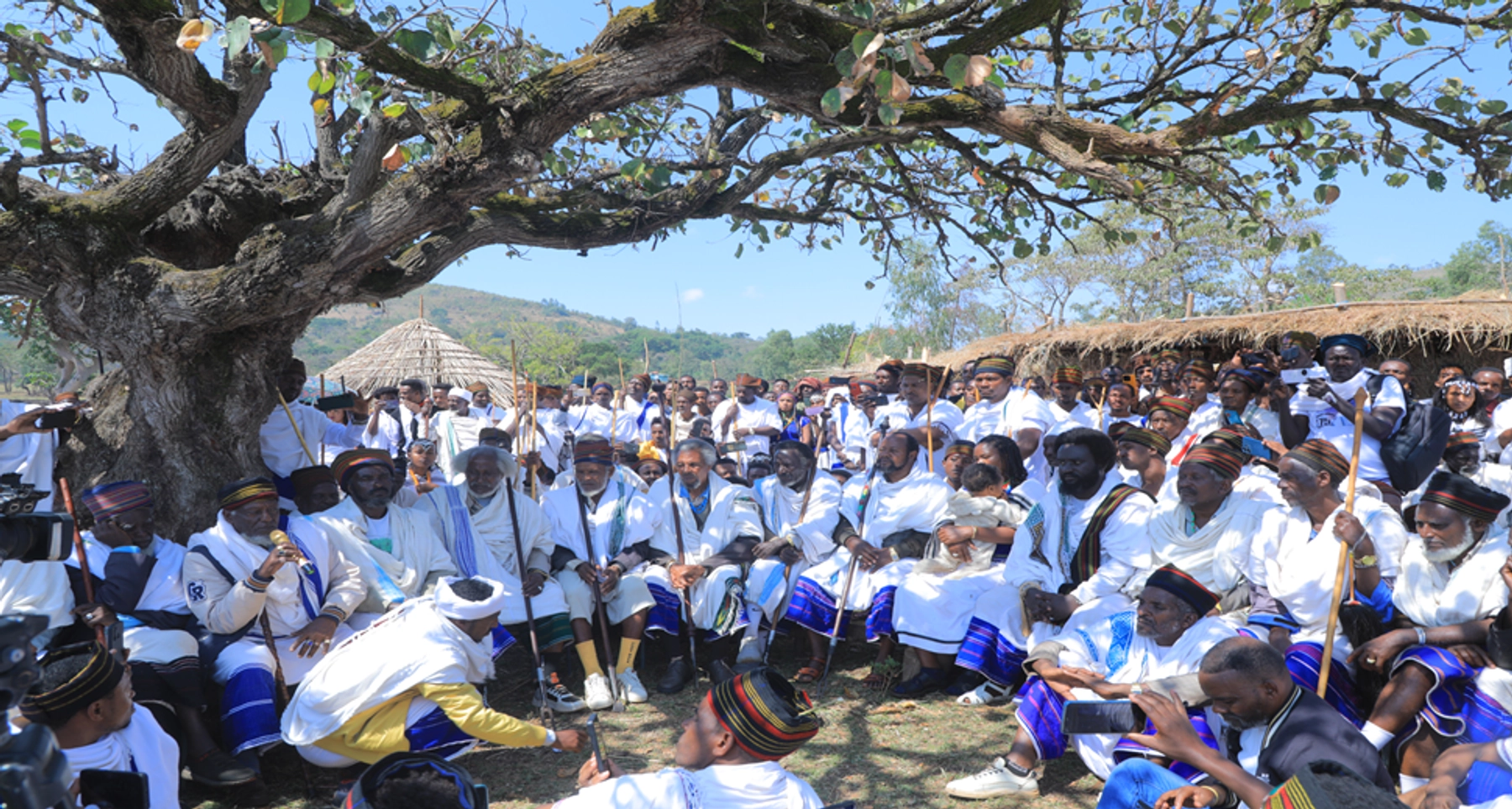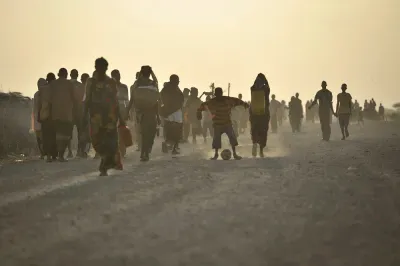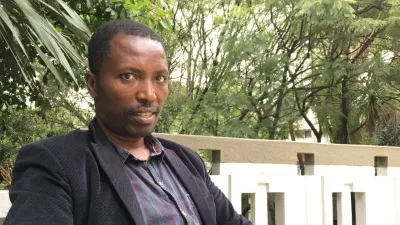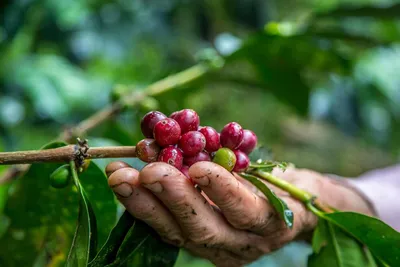A Reflection on Hasse Jila in the Guji Gadaa System: Halo, Abaya District as case study

Jila celebration of Guji Halo Mokona at Hasse Jila, in Abaya District
Inscribed as one of humanity’s ‘Intangible Cultural Heritage’ by the United Nations Educational, Scientific and Cultural Organization (UNESCO), the Gadaa System is an indigenous Oromo institution, an umbrella under which they carry out administrative, religious, political, and economic functions of their society.
As an egalitarian system of indigenous governance, Gadaa has its own constitution that regulates life in its all aspects in which it governs: people, animals, plants, etc. Based on this, the Abbaa Gadaas (elected leaders) govern the people by peacefully handing over the ‘baallii,’ or power, to each other every eight years.
Origins and Home Bases of the Guji Oromo
Geographically, Guji Land is believed to be located between 43°N and 41°N latitudes and 40°38’E and 60°38’E longitudes, administered in two Guji Zones, East and West. Like other Oromo groups, a certain number of Guji people are thought to have moved away and expanded over the expanse of East Africa.
The Guji Gadaa has four indigenous governance structures named after their traditional dwelling areas (Goorees): Uraagaa, Maattii, Hokkuu, and Haloo. These divisions also define their settlement patterns: Uraagaa (Central Guji), Maattii (northern Booree Highlands), Hokkuu (southern region), and Haloo (northwest Guji.)
These four Guji branches share common boundaries, known as Gabala, which are significant for their Gadaa rituals prior to attending the Me’e Bokkoo Assembly.
Most significantly, one assembly, Gumii Bokko, embraces the entire Guji, with Qaalluu serving as its spiritual leader. In the Guji Gada system, the Gada Leadership, which holds Abbaa Gadaa power, rotates among five parties (Balli Shanan/Fincaan Shanan) every eight years. They are:
- Mudana
- Halchisa
- Dhallana
- Harmufa and
- Robale
The Guji Gadaa administrative and ritual practices begin at the grassroots level (Gooree) and then move up to Gooroo Quttumaa. These are 4 Guji Haganas: Uraga, Matti, Hokku, and Halo/Level; and finally, at the Gumi Bokko General Assembly. Documentation should clearly identify the seven Guji-dwelling /Quttuma/ areas. Namely:
- Uraagaa
- Maattii
- Hookku
- Haloo
- Weessituu
- Oottuu
- Sheelloo
Of these, Uraga, Matti, Hokku, and Halo dwell in a consecutive manner; that is, they have contacting borderlines, while the remaining three 1) Weessituu 2) Oottuu and 3) Sheelloo have been detached from the Central Guji Land, and they are surrounded by neighboring ethnic groups, such as Sidama, Alaba/Hadiya, and others (SENNP’S Groups). They have lived in their original dwellings, despite being surrounded by the aforementioned groups.
The Guji are also present in various regions of Oromia, including the Borena Zones and their respective districts. In the Arero District, residents inhabit the kebeles of Halluu, Madar, Oolloo, Gallaba, Dhidhiillee, Rannu, Hirmaayyee, and Dirree Halluu. Similarly, the villages of the Gomole District—Dhaka Barruu, Bildiimii Raso, Keellee Quufaa, and Suruphaa—along with the adjacent rural areas, including Tulluu Qobboo, Tulaa Waayyuu, Seelee, and Buuyyaa. The Guji also live in Dhedheertuu Village, which is located in Eelaweyyee District, Borena Zone.
The Guji inhabit Bidre, Oborso, and Dallo Manna in the neighboring Bale Zone. The Kebeles where the Guji are found include Oda, Oborso and its surroundings, Dannisa, Karkarro, Oda Gagura, Liqimsa, Bokoree, Danbiyyoo River, Warqaa, Bubbee Gurjaa, Gurraa Warqaa, and Arsiittuu.
Across the Gannaalee River, the Guji dwelling areas extend into the previous Harooressa Awraajjaa, now structured into the Sidama Region or West Arsi Zone. Here again, the following villages are cited as areas where the Guji community either used to live or still could be found: Baddeessaa, Malka Hadhoo, Bocceessaa, Nansaboo Qabiyyee, Nansaboo Goxee, Hurroo Borroo, and Warqaa area, as well as in and around Wondo Gannat District.
Historically, indigenous Oromo communities, including the Guji, are believed to have migrated to the current East Shawa Zone along the Great Rift Valley and settled in the Hawas River Basin, where they left historical traces. The Jiillee (also known as Gujii Jiillee) community, located near the Qoqa Dam/Hawash River, encompasses villages such as Batu and Dugda Boora, among others.
Outside of Oromia, the Guji community is found in the Arba Minch and Gamo districts of the South Ethiopia Regional State. Here, the Guji reside in villages such as Gizoola, Laanxee, Obbicha Biraamee, Misigiidaa, and Muraasa. In the Central Region of Ethiopia, they are located in the Alaaba area and the Duuramee Kambaataa districts. Within the Gedeo Zone, the Guji community is present in Fissahaa Gannat, Yirgaacaffee, Wanaago, and Bulee (formerly Bulee Goo Goolaa). In the Sidaamaa Zone, the Guji are found in Hagereselam (Hulaa), Hookkoo district, Harooressa, Malagaano, Bansaa-Daayee, Shabbadiinoo, and Baddeessaa. Additionally, the presence of a locality named Guji Gattaree on Xaanaa (Lake Tana) Island in the Amhara Regional State raises important questions about historical Oromo presence in the area.
Gadaa Constituency (Hagana) Restored For Guji Halo
The Halo Mokkonnaa Guji, also known as the Alaaba or Allaadduu Guji, inhabit the Qaalluu Gabala area, particularly in the Abbaaya and Galaana districts. Like other major Guji subdivisions—namely Uraga, Matti, and Hokku—the Halo Mokkonnaa Guji are organized into Balbala Torba, literally ‘seven doors.’ It is customary among the Guji to ask, upon meeting someone for the first time, “Fira kami?”—meaning “From which Door are you?”—as a way of establishing lineage and communal ties.
The Halo Mokkonna Seven Doors are
| No | Clans (Gosa) | Subclans (Mana) |
| 1 | Obbitu | Hadiyya, Kale, Shundhitu, Wodhadhu, Darimu, Jarso Guda, Jarso Diqa (Dade), Gajabo, and Hulo |
| 2 | Dhaantu | Babba, Yayya, Galalcha, Nonno |
| 3 | Aanoltu | Tona, Dawicha, Bicco, and Bude |
| 4 | Meerritu | Babba, Wonditu, Gasara, and Galalcha |
| 5 | Massintuu | Garada, Kochitu, Konnono, and Biyyale |
| 6 | Hangeetu | Hangetu, and Garada |
| 7 | Baalla | Dulo, and Banqato |
Source: Guji elders
The Halo Mokkonna Gadaa Administration
According to oral narratives and supporting evidence, the Halo Mokkonnaa Guji maintained their own Gadaa representation within the General Gumi Bokko Assembly. Despite the suppression and interruption of the Oromo Gadaa system across many regions of Oromia, the Halo Guji successfully revived their traditional governance system following the overthrow of the Ethiopian monarchy in 1974.
Today, all five Guji Gadaa baallis (parties) actively perform their roles, and the emerging Halo Abba Gadaa formally receives the qumbi (oath) from the Qaalluu, signifying spiritual legitimacy. Structurally, the Halo—like the Uraga, Matti, and Hokku—possesses three hagana (upper grades): Raaba, Dori, and Gadaa, as well as five fincaan or baallis: Mudana, Halchisa, Dhallana, Harmufa, and Robale.
Historically, the Halo maintained numerous Arda Jila (Gadaa ritual sites) not only within their territories but also in adjacent areas inhabited by the Gedeo and Sidama peoples, indicating a broader regional influence and intercommunal significance of the Gadaa System.
These Arda Jila (Gadaa ritual sites), located within the Halo Gabala (Gadaa territory), are now slated for reactivation following a recent decision by the Gumi Bokko Assembly. Historical artifacts and research evidence indicate that the Halo Mokkonnaa Guji practiced the Gadaa system in a highly organized and coordinated manner. The first Abbaa Gadaa of Halo Gabala—Goro Quttuma Halo—was named Halo Mokkonnaa and served from 1424 to 1431. Oral accounts suggest that the Gadaa cycles continued uninterrupted up to the 67th Abbaa Gadaa, Bariso Guye, who held office from 1952 to 1959. Following this period, the Gadaa system in the region, as in much of Oromia, was targeted by Abyssinians. However, the 75th Guji Gadaa Assembly, held at Me’e Bokko in 2024, has officially declared the restoration of the Halo Mokkonnaa Gadaa and nominated a new Abbaa Gadaa for the constituency.
The cyclical structure of leadership will now resume, in line with the established practices of other Guji Gadaa territory systems—namely Uraga, Matti, and Hokku. With this restoration, the Halo Mokkonnaa area has been formally recognized as the fourth Gadaa territory, with the cycle beginning anew from the year 2024.
Importantly, the spiritual authority of the Qaallu institution has remained intact throughout this period. The 19th Qaallu is currently active, continuing an unbroken line of religious service. With its political and spiritual institutions now fully restored, the Halo Mokkonnaa Guji Gadaa constituency is poised to reconnect with and incorporate peripheral Guji communities, such as those in Ottu, Shello, and other surrounding areas.
We need your support
We trust you found something of value in this article. If so, we kindly ask you to consider helping Curate Oromia continue its work.
If you believe in the importance of independent voices and honest reporting, we invite you to support our efforts through our GoFundMe campaign.
Every contribution, however small, goes directly to our writers and the expansion of our reach.
Thank you for your support.



